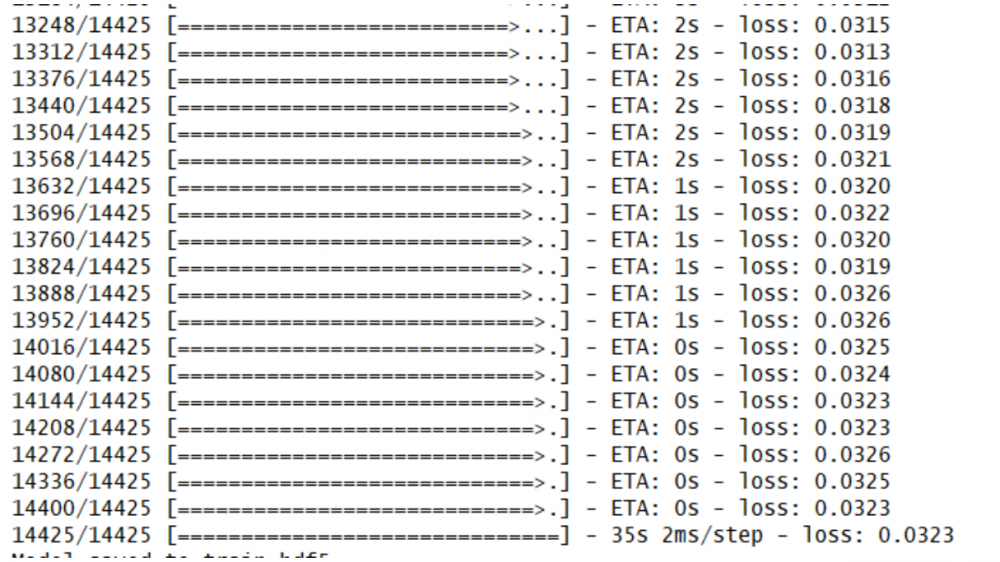引言:
“那些听不到音乐的人,以为跳舞的人疯了。” 尼采这句话好有趣,也告诉我们音乐对于日常生活的不可或缺之处。但是对于一般人来说,想要精通各种乐器难度较高。故今天我们来实践一个普通人可以制作的音乐项目,用深度学习的方法让计算机自动生成自己需要的音乐。完整代码见文末。
其中生成的效果如下可见:

模型建立
1.1 环境要求
本次环境使用的是python3.6.5+windows平台,主要用的库有:
Argparse库是python自带的命令行参数解析包,可以用来方便地读取命令行参数;
glob获取本地文件,在这里用来快速获取训练数据集;
Pickle用在机器学习中,可以把训练好的模型存储起来,这样在进行决策时直接将模型读出,而不需要重新训练模型,这样就大大节约了时间。它可以序列化对象并保存到磁盘中,并在需要的时候读取出来,任何对象都可以执行序列化操作。
Keras库是一个高层神经网络API,Keras由纯Python编写而成并基Tensorflow、Theano以及CNTK后端。Keras的核心数据结构是“模型”,模型是一种组织网络层的方式。Keras中主要的模型是Sequential模型,Sequential是一系列网络层按顺序构成的栈。在这里我们用它来建立BLSTM模型
1.2 数据集处理
本项目使用了音乐文件是midi文件,因为它们易于解析和学习使用midi文件给我们带来了很多好处,因为我们可以轻松地检测到音符的音高和持续时间。在本次项目中,时间步长和序列长度是网络的两个重要因素。时间步长决定了我们分析和产生每个音符的时间,而序列长度决定了我们如何学习歌曲中的模式。设定0.25秒的时间步长和每个时间步长8个音符。这对应于4/4的拍号,对我们来说意味着8个不同的序列,共4个音符。通过学习这些序列并重复它们,我们可以生成听起来像实际音乐的模式,并以此为基础进行构建。
音乐的重要组成部分是可变长度音符和休止符的动态和创造性使用。比如先是发出的长长的音符,然后是平静的停顿,可以在听我们听到演奏者的心灵倾泻而出的声音时,向听众发出一波情感。为了捕捉到这一点,引入长音符,短音符和休止符的方法,以便我们可以在整首歌曲中产生不同的情感。
(1)获取训练集所有的音符和****
notes = []
for file in self.songs:
print("Parsing %s" % file)
try:
midi = converter.parse(file)
except IndexError as e:
print(f"Could not parse {file}")
print(e)
continue
notes_to_parse = None
try:
s2 = instrument.partitionByInstrument(midi)
notes_to_parse = s2.parts[0].recurse()
except:
notes_to_parse = midi.flat.notes
prev_offset = 0.0
for element in notes_to_parse:
if isinstance(element, note.Note) or isinstance(element, chord.Chord):
duration = element.duration.quarterLength
if isinstance(element, note.Note):
name = element.pitch
elif isinstance(element, chord.Chord):
name = ".".join(str(n) for n in element.normalOrder)
notes.append(f"{name}${duration}")
rest_notes = int((element.offset - prev_offset) / TIMESTEP - 1)
for _ in range(0, rest_notes):
notes.append("NULL")
prev_offset = element.offset
with open("notes/" + self.model_name, "wb") as filepath:
pickle.dump(notes, filepath)1.3 神经网络处理成序列
为了建立BLSTM网络,需要将数据处理成序列形式。
def prepare_sequences(self, notes, n_vocab): # 获取所有pitch 名称 pitchnames = sorted(set(item for item in notes)) # 创建一个字典来映射音高到整数 note_to_int = dict((note, number + 1) for number, note in enumerate(pitchnames)) note_to_int["NULL"] = 0 network_input = [] network_output = [] for i in range(0, len(notes) - SEQUENCE_LEN, 1): sequence_in = notes[i : i + SEQUENCE_LEN] sequence_out = notes[i + SEQUENCE_LEN] network_input.append([note_to_int[char] for char in sequence_in]) network_output.append(note_to_int[sequence_out]) n_patterns = len(network_input) network_input = numpy.reshape(network_input, (n_patterns, SEQUENCE_LEN, 1)) network_input = network_input / float(n_vocab) print(network_output) network_output = np_utils.to_categorical(network_output) return (network_input, network_output)
1.4 模型网络建立
通过在歌曲中某个特定位置建立之前和之后的音符,可以生成听起来与人类相似的旋律。通常,在听音乐时,之前发生的事情可以帮助听众预测接下来的音节。很多时候我一直在听一首歌,我可以随着特定的节奏跳动,因为我可以预测接下来会发生什么。这恰恰是在增加一首歌曲时发生的情况。比如这首歌变得越来越强烈,这使听众在预期落下时会产生紧张感,并在最终击打时产生那种放松和兴奋的时刻。通过利用这一点,我们能够产生听起来自然的节奏,并产生出我们已经习惯于现代音乐中期望的相同情感。
对于BLSTM层中的节点数,我们选择512。对于激活函数,我们选择softmax。对于损失函数,我们选择交叉熵,因为它们可以很好地解决诸如音符预测之类的多类分类问题。最后,我们选择RMSprop作为优化程序,这是Keras为RNN推荐的。
def train(self, network_input, network_output):
""" train the neural network """
filepath = (
self.model_name + "-weights-improvement-{epoch:02d}-{loss:.4f}-bigger.hdf5"
)
checkpoint = ModelCheckpoint(
filepath, monitor="loss", verbose=0, save_best_only=True, mode="min"
)
callbacks_list = [checkpoint]
self.model.fit(
network_input,
network_output,
epochs=self.epochs,
batch_size=64,
callbacks=callbacks_list,
)
def create_network(network_input, n_vocab):
print("Input shape ", network_input.shape)
print("Output shape ", n_vocab)
""" create the structure of the neural network """
model = Sequential()
model.add(
Bidirectional(
LSTM(512, return_sequences=True),
input_shape=(network_input.shape[1], network_input.shape[2]),
)
)
model.add(Dropout(0.3))
model.add(Bidirectional(LSTM(512)))
model.add(Dense(n_vocab))
model.add(Activation("softmax"))
model.compile(loss="categorical_crossentropy", optimizer="rmsprop")
return model音乐生成
创作音乐最重要的部分之一就是结构。我们设定结构形式如下,我们从随机音符中生成了第一节音律,然后根据第一条音律生成了第二节音律。实际上,这将生成一个两倍的长度并将其分成两半的部分。这里的思考过程是,如果我们创作一首音乐,那么第二首音乐仍应符合相同的氛围,并且通过将第一首音乐作为参考,我们可以实现这一目标。
(1)根据音符序列从神经网络中生成音符
def get_start():
# pick a random sequence from the input as a starting point for the prediction
start = numpy.random.randint(0, len(network_input) - 1)
pattern = network_input[start]
prediction_output = []
return pattern, prediction_output
# generate verse 1
verse1_pattern, verse1_prediction_output = get_start()
for note_index in range(4 * SEQUENCE_LEN):
prediction_input = numpy.reshape(
verse1_pattern, (1, len(verse1_pattern), 1)
)
prediction_input = prediction_input / float(n_vocab)
prediction = model.predict(prediction_input, verbose=0)
index = numpy.argmax(prediction)
print("index", index)
result = int_to_note[index]
verse1_prediction_output.append(result)
verse1_pattern.append(index)
verse1_pattern = verse1_pattern[1 : len(verse1_pattern)]
# generate verse 2
verse2_pattern = verse1_pattern
verse2_prediction_output = []
for note_index in range(4 * SEQUENCE_LEN):
prediction_input = numpy.reshape(
verse2_pattern, (1, len(verse2_pattern), 1)
)
prediction_input = prediction_input / float(n_vocab)
prediction = model.predict(prediction_input, verbose=0)
index = numpy.argmax(prediction)
print("index", index)
result = int_to_note[index]
verse2_prediction_output.append(result)
verse2_pattern.append(index)
verse2_pattern = verse2_pattern[1 : len(verse2_pattern)]
# generate chorus
chorus_pattern, chorus_prediction_output = get_start()
for note_index in range(4 * SEQUENCE_LEN):
prediction_input = numpy.reshape(
chorus_pattern, (1, len(chorus_pattern), 1)
)
prediction_input = prediction_input / float(n_vocab)
prediction = model.predict(prediction_input, verbose=0)
index = numpy.argmax(prediction)
print("index", index)
result = int_to_note[index]
chorus_prediction_output.append(result)
chorus_pattern.append(index)
chorus_pattern = chorus_pattern[1 : len(chorus_pattern)]
# generate bridge
bridge_pattern, bridge_prediction_output = get_start()
for note_index in range(4 * SEQUENCE_LEN):
prediction_input = numpy.reshape(
bridge_pattern, (1, len(bridge_pattern), 1)
)
prediction_input = prediction_input / float(n_vocab)
prediction = model.predict(prediction_input, verbose=0)
index = numpy.argmax(prediction)
print("index", index)
result = int_to_note[index]
bridge_prediction_output.append(result)
bridge_pattern.append(index)
bridge_pattern = bridge_pattern[1 : len(bridge_pattern)]
return (
verse1_prediction_output
+ chorus_prediction_output
+ verse2_prediction_output
+ chorus_prediction_output
+ bridge_prediction_output
+ chorus_prediction_output
)(2)将预测输出转换为notes,并从notes创建midi文件。根据模型生成的值创建note和chord对象。
for pattern in prediction_output:
if "$" in pattern:
pattern, dur = pattern.split("$")
if "/" in dur:
a, b = dur.split("/")
dur = float(a) / float(b)
else:
dur = float(dur)
# pattern is a chord
if ("." in pattern) or pattern.isdigit():
notes_in_chord = pattern.split(".")
notes = []
for current_note in notes_in_chord:
new_note = note.Note(int(current_note))
new_note.storedInstrument = instrument.Piano()
notes.append(new_note)
new_chord = chord.Chord(notes)
new_chord.offset = offset
new_chord.duration = duration.Duration(dur)
output_notes.append(new_chord)
# pattern is a rest
elif pattern is "NULL":
offset += TIMESTEP
# pattern is a note
else:
new_note = note.Note(pattern)
new_note.offset = offset
new_note.storedInstrument = instrument.Piano()
new_note.duration = duration.Duration(dur)
output_notes.append(new_note)
# 增加每次迭代的偏移量,这样笔记就不会堆积
offset += TIMESTEP
midi_stream = stream.Stream(output_notes)
output_file = os.path.basename(self.weights) + ".mid"
print("output to " + output_file)
midi_stream.write("midi", fp=output_file)源码
完整代码下载链接:
https://pan.baidu.com/s/1uPflHi1u6Vl_J_L7Q_JFaA
提取码:8n1p
*博客内容为网友个人发布,仅代表博主个人观点,如有侵权请联系工作人员删除。